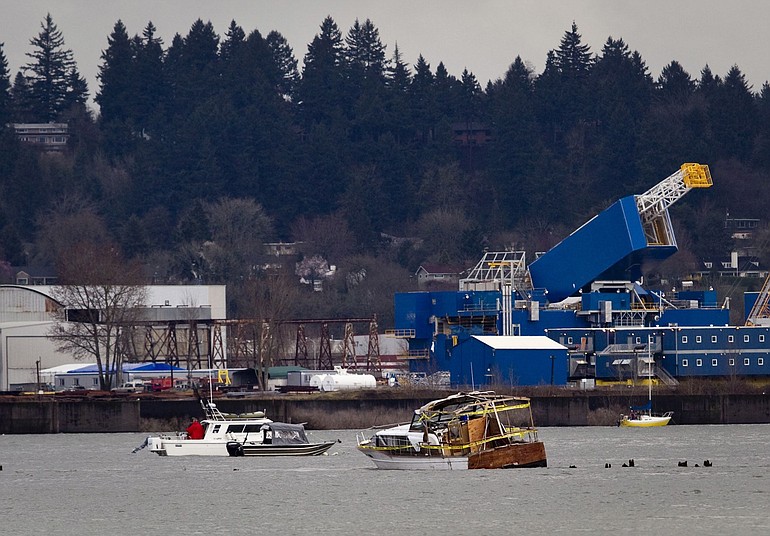PORTLAND — Another week, another stranded vessel on the Columbia River.
A small boat now teeters unevenly at the eastern tip of Hayden Island, impaled on the piers of a wing dam. It marks the latest in a spate of groundings over the past couple of months between Vancouver and Portland.
Authorities say this particular vessel doesn’t pose an immediate threat to the environment or river navigation.
“It’s safe, and it’s out of the channel,” said Multnomah County sheriff’s Deputy Jason Tyrus, a member of the sheriff’s river patrol unit.
Yet the vessel’s deteriorated condition may ultimately require a public agency to remove it.
Even though this boat’s plight doesn’t rise to the level of another more notorious shipwreck farther upriver, it does underscore the inability of public agencies to exercise control over festering problems on the water before they descend into crisis.
“What’s the appropriate role of the state or federal government whenever you’ve got private property that represents a threat to public safety or health — either because it’s weak structurally or it has materials on board that are hazardous?” said Jim Sachet, cleanup coordinator for the Washington Department of Ecology. “We have a process that takes time to play out … to give due process to vessel owners when they’re able to participate.”
Some owners are unable or unwilling to participate.
The 431-foot Davy Crockett, beached and broken on the north shore of the Columbia between Vancouver and Camas, is the most egregious local example. Contractors had burned through $7 million as of last week in the federal recovery operation, which began after the vessel’s owner walked away after partially scrapping the converted Liberty ship.
The Crockett, which languished virtually untended for two decades, is not the only vessel to raise warning flags among area boaters.
As the Crockett debacle began to unfold two months ago, longtime Vancouver-area boater Wayne Monroe observed that it’s not uncommon to see old boats fall into disrepair as they bounce between owners. Even owners with the best of intentions often find they lack the resources, interest or wherewithal to properly care for their boats.
Monroe recalled when it was simpler to dispose of vessels that had outlived their purpose.
“For years, boats have just been tied up against a bank someplace,” Monroe said. “It always used to be legal because no one cared about the river.”
Times are changing.
Just a few hundreds yards upstream from the Davy Crockett, the floating dock previously owned by the old Vancouver Yacht Club bobs up and down in the water against the north bank. Owner Rick Dulas reportedly purchased the assemblage for $1 from the Port of Camas-Washougal, which wanted to get rid of the vacant structure.
Dulas managed to tow it a few miles downriver before getting permission from an elderly shoreline owner to temporarily tie it up while he finalized plans for a permanent moorage near Jantzen Beach.
That was two years ago.
State agencies, the property owner and Clark County’s code enforcement office have been pressing since 2009 to have the structure removed.
Representatives of federal, state and local agencies say they have little authority to compel an owner to remove private property. As long as it isn’t actively leaking hazardous material into the water or blocking navigation, U.S. Coast Guard Capt. Daniel LeBlanc said his agency can’t just commandeer someone’s private property.
The Davy Crockett had been the subject of periodic complaints and at least one oil spill two years ago.
But LeBlanc said the Coast Guard had little cause to intervene until owner Brett Simpson jeopardized the integrity of the hull by cutting it apart late last year.
“It was a very minimal risk at that point in time because it was structurally sound,” LeBlanc said. “Had it not been for the actions of the owner, we would not have had a full-blown operation like we have now.”
Washington’s Department of Natural Resources operates a derelict vessel removal program, but it’s limited to boats of less than 200 feet in length, and its $1.7 million budget is stretched thin.
Across the river
Oregon has only a fraction of Washington’s financial resources for derelicts, said Mike Greenburg, the Oregon Department of Environmental Quality’s on-scene cleanup coordinator for the Davy Crockett. Oregon can only act when a vessel constitutes an environmental or safety hazard — and only after it completely sinks.
The state has less than $200,000 annually to remove known derelicts. Identifying potential threats is a low priority.
“Those are underfunded programs,” Greenburg said, “and we are in the process of evaluating and researching what is out there in our river system.”
In light of the Davy Crockett debacle, Washington Gov. Chris Gregoire recently called for better coordination among state, local and federal agencies in identifying problematic vessels before they pollute the environment or prompt an expensive taxpayer-funded cleanup.
Regulators are keeping a close eye on another old barge previously owned by Simpson upriver at Dallesport. According to a citation by the Army Corps of Engineers, Simpson had illegally filled the river’s shoreline while scrapping the vessel across the river from The Dalles, Ore.
Lorri Epstein, water quality coordinator with the environmental group Columbia Riverkeeper, said the Department of Ecology assured her that the vessel seems relatively intact.
“Ecology says it’s not an immediate threat right now,” she said. “That’s great, but maybe we shouldn’t wait until it’s leaking.”
The boat impaled on the wing dam near Hayden Island doesn’t have much in the way of fuel on board and pales in comparison to the Davy Crockett, according to Terry Truan, dock master with the nearby Portland Yacht Club, who knows the owner. However, he said local authorities could have been more proactive in making sure the boat was securely anchored after the owner encountered a health problem.
“The Coast Guard and river patrol didn’t want to touch it,” Truan said. “When it breaks apart, which it will eventually, it’ll present a hazard,”
Erik Robinson: 360-735-4551, or erik.robinson@columbian.com.



